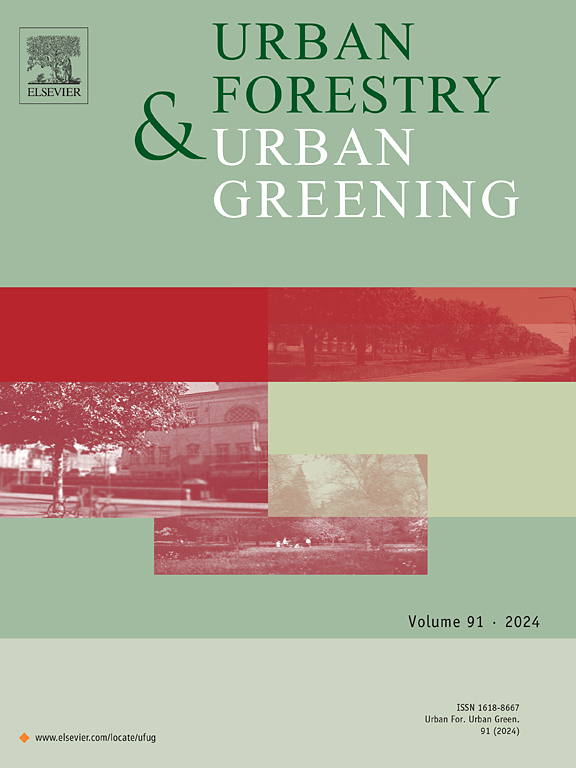探索城市绿地暴露对呼吸系统健康的影响途径:中国南京的实证研究
IF 6
2区 环境科学与生态学
Q1 ENVIRONMENTAL STUDIES
引用次数: 0
摘要
绿地(GS)暴露与呼吸系统健康之间的关联途径不断激发学者们的研究兴趣。然而,绿地暴露与呼吸健康之间的多维关联机制仍有待澄清。因此,本研究旨在构建一个研究框架,在动态量化多维暴露指标(空间暴露和视觉暴露)的基础上,探索影响假设途径(身体活动、空气污染)的机制。本研究以中国南京的城市绿地为样本进行了试点实验。通过偏最小二乘法(PLS)建模探讨了GS暴露通过体育活动和空气污染对呼吸健康的平行中介效应,并探讨了GS暴露水平的差异对这一平行中介模型的影响。结果表明,由多个指标组成的动态监测系统更有利于描述人群实际的 GS 暴露情况。促进体育锻炼和降低空气质量都是影响GS暴露和呼吸健康的中介途径,其中体育锻炼是最关键的中介变量,分别占总间接效应的43.06%和51.02%。而年龄、体重指数和性别等变量并不影响该机制。在城市绿地中进行短期暴露对呼吸健康的促进作用具有至少 4 小时的滞后效应。这项研究的结果将有助于环境流行病学家阐明绿地系统影响呼吸健康的途径和机制,并为地方政府实施高效、有利于呼吸健康的绿地规划和设计提供证据。本文章由计算机程序翻译,如有差异,请以英文原文为准。
Exploring the pathways of urban green space exposure on respiratory health: An empirical study in Nanjing, China
Pathways of association between green space (GS) exposure and respiratory health continue stimulating scholars' research interest. However, the mechanisms underlying the multidimensional association between GS exposure and respiratory health remain to be clarified. Therefore, this study aimed to construct a research framework for exploring the mechanisms affecting the hypothesized pathways (physical activity, air pollution) based on the dynamic quantification of multidimensional exposure indicators (spatial and visual exposure). This study used urban green spaces in Nanjing, China, as sample sites for a pilot experiment. The parallel mediating effect of GS exposure on respiratory health through physical activity and air pollution was explored by partial least squares (PLS) modeling, and the effect of differences in GS exposure levels on this parallel mediating model was explored. The results showed that a dynamic monitoring system of multiple indicators is more conducive to characterizing the actual GS exposure of the population. Promoting physical activity and reducing air quality were both mediating pathways affecting GS exposure and respiratory health, with physical activity being the most critical mediating variable, accounting for 43.06 % and 51.02 % of the total indirect effects, respectively. And variables such as age, BMI, and gender do not affect the mechanism. The respiratory health-promoting benefits of performing short-term exposure in urban green spaces had a lagged effect of at least 4 hours. The results of this study will help environmental epidemiologists to elucidate the pathways and mechanisms by which the green space system affects respiratory health and provide evidence for local governments to implement efficient and respiratory-healthy green space planning and design.
求助全文
通过发布文献求助,成功后即可免费获取论文全文。
去求助
来源期刊

Urban Forestry & Urban Greening
FORESTRY-
CiteScore
11.70
自引率
12.50%
发文量
289
审稿时长
70 days
期刊介绍:
Urban Forestry and Urban Greening is a refereed, international journal aimed at presenting high-quality research with urban and peri-urban woody and non-woody vegetation and its use, planning, design, establishment and management as its main topics. Urban Forestry and Urban Greening concentrates on all tree-dominated (as joint together in the urban forest) as well as other green resources in and around urban areas, such as woodlands, public and private urban parks and gardens, urban nature areas, street tree and square plantations, botanical gardens and cemeteries.
The journal welcomes basic and applied research papers, as well as review papers and short communications. Contributions should focus on one or more of the following aspects:
-Form and functions of urban forests and other vegetation, including aspects of urban ecology.
-Policy-making, planning and design related to urban forests and other vegetation.
-Selection and establishment of tree resources and other vegetation for urban environments.
-Management of urban forests and other vegetation.
Original contributions of a high academic standard are invited from a wide range of disciplines and fields, including forestry, biology, horticulture, arboriculture, landscape ecology, pathology, soil science, hydrology, landscape architecture, landscape planning, urban planning and design, economics, sociology, environmental psychology, public health, and education.
 求助内容:
求助内容: 应助结果提醒方式:
应助结果提醒方式:


